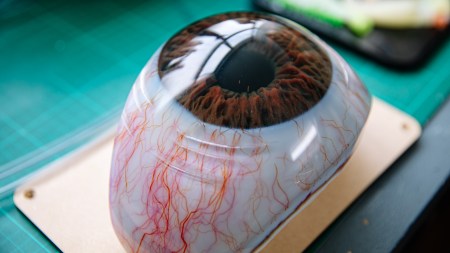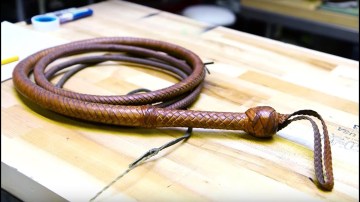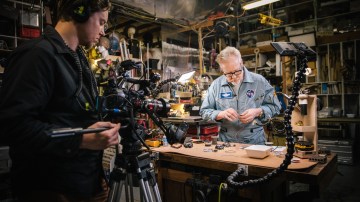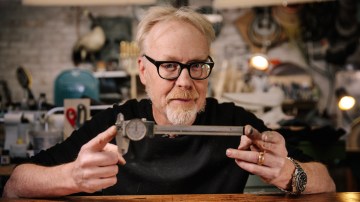How To Make a Gory Hand Prop!
We visit Frank Ippolito’s shop to learn about making ultra-realistic fake hands as Halloween props. Frank walks us through the step-by-step process of molding your own hand and making a silicone casting, and then cutting and painting up the fake hand to look realistically gory. It’s actually a special effect you can do by yourself without any assistance! (This video was brought to you by Premium memberships on Tested. Learn more about how you can support us by joining the Tested Premium community!)
Video shot and edited by Joey Fameli
Music Library provided by Jingle Punks
Thanks to Smooth-On for providing materials for this video
21 thoughts on “How To Make a Gory Hand Prop!”
Leave a Reply

One Day Builds
Adam Savage’s One Day Builds: Life-Size Velocirapt…
Adam embarks on one of his most ambitious builds yet: fulfil…

Show And Tell
Adam Savage’s King George Costume!
Adam recently completed a build of the royal St. Edwards cro…
All Eyes On Perserverance – This is Only a Test 58…
We get excited for the Perserverance rover Mars landing happening later today in this week's episode. Jeremy finally watches In and Of Itself, we get hyped for The Last of Us casting, and try to deciper the new Chevy Bolt announcements. Plus, Kishore gets a Pelaton and we wrack our brains around reverse engineering the source code to GTA …

One Day Builds
Mandalorian Blaster Prop Replica Kit Assembly!
Adam and Norm assemble a beautifully machined replica prop k…
House of MCU – This is Only a Test 586 – 2/11/21
The gang gets together to recap their favorite bits from this past weekend's Superb Owl, including the new camera tech used for the broadcast and the best chicken wing recipes. Kishore shares tips for streamlining your streaming services, and Will guests this week to dive into the mind-bending implications of the latest WandaVision episod…

One Day Builds
Adam Savage’s One Day Builds: Royal Crown of Engla…
One of the ways Adam has been getting through lockdown has b…

Making
Adam Savage Tests the AIR Active Filtration Helmet…
Adam unboxes and performs a quick test of this novel new hel…

Making
Weta Workshop’s 3D-Printed Giant Eyeballs!
When Adam visited Weta Workshop early last year, he stopped …

One Day Builds
Adam Savage’s One Day Builds: Wire Storage Solutio…
Adam tackles a shop shelf build that he's been putting off f…

Show And Tell
Mechanical Dragonfly Automata Kit Build and Review
Time for a model kit build! This steampunk-inspired mechanic…


























I’m itching to try this out. Is it at all possible for you guys to do a detailed write-up for this video that gives a bit more detail about some of the aspects of the build? Stuff like details about the different materials used (names of products/materials, potential places to get them from), and some notes about each step of the process? I have never done anything like this before, but have always been fascinated by it – basically, a complete and utter novice. While I understand the theory of these kinds of builds, it’s a little daunting for someone like me (and I imagine others) to find places that have really good, clear instructions and a suitably detailed video to go along with it.
Awesome video for sure! I love these in depth videos on effects. What I would love to see is a video dedicated to kitbashing and making models for movies.
Great video!
That last spray with the matte finish really tied the whole paint job together.
I was stoked to see this video up. Even more stoked as I watched it.
Love the coloring advice when it comes to the skin tones, I never really though about using an olive drab to really fix in the variations of colors.
The translucent nature of the silicon really works well for the not quite so fresh wound. It reminded me of a few nasty work place injures I saw/experienced. Where the skin is kinda void of blood, from putting pressure on the area. Where the skin is more bleached out since you have had the pressure also reducing the level of blood flow from the capillaries. While this isn’t quite as gory as super fresh wounds. Anyone who has seen this stuff first hand will generally have a reaction if that is part of the goal.
Any video with Frank usually turns out to be a good one
Fantastic! keep these coming!
I’ve had my arms cast in algenate before. It is strangely pleasing.
If you ever wanted to know what a chainsaw would do to your hand if you were a little drunk and careless, now you know, 😨
Like many people I first saw Frank on Face Off and arguably that was not a great showing… through Tested though I have been able to see his true talent and especially in this video he plays the role of teacher very well. Beautiful work Frank and thank you for giving us an insight on how to perform some of the wonderful FX tricks we all love!
As one of my future endeavors is to start making DIY horror movies, I’m so glad this video got made (and that I helped in some small part to make it happen). you’re a pretty amazing teacher and so cool for helping to disseminate the insider knowledge of practical effects. I’ve known a handful of effects artists over the years, and they were always kind of jerks about letting/helping anyone that wasn’t already established learn anything about the trade.
When the painting starts you see the true artist that Frank is. That is remarkably life-like!
Question; it might have been shown but I was multi-tasking at one point so I might have missed it; how does the airbrush work? When he was adding the olive tones near the end (the yellow-ish) he poured some in a small cup and the next shot boom he was spraying?
This actually looks easy enough to try at home so I’m searching Amazon for alginate and silicone.. but now I’m wondering if I should be buying some kind of kit instead… maybe something that comes with enough of the materials and the dye… Just wondering if anyone has a recommendation.
EDIT: I wonder if an art store would carry this stuff?
For the record in the video they use “Algi-Safe” brand alginate and Mold Star 20T two part silicone.
Frank mentions the use of plaster and it not being a great idea, there are a couple of storys of a schoolkid who did a hand case (i think it was both hands) and lost maybe 4 out of 5 fingers on each hand because of burning, blocks of plaster get REALLY hot.
I gave this a go a while back, I used the same body double silicone Frank used in some previous videos, then filled with a polyurethane resin, I think it worked rather well 🙂
Unfortunately I made the rubber moulds a bit thick, and ended up tearing them when I was getting the casting out, but I’ll certainly try it again at some point – I’ve a few random fingers around as well, which I think I’m going to make into a creepy coat hook rack at some point 😀
I was so inspired by this that I had to try it out myself! I’m a complete novice in this field but I took you by your word that this could easily be done at home 🙂
I was lucky to get some NVT two-component silicone from a little hobby shop nearby and poured it into a mould I made from alginate. Thing is, I waited 6 hours for it to cure but still nothing happened. So I looked at the bottom of the can and noticed that the product was only best before june 2014. Does this mean it won’t cure at all or that it’ll just take much more time?
Love what you’re doing!
Max
I guess it depends on the type silicone it was – there are a ton of different silicone compounds out there, and they can go anywhere from a few minutes to cure or 24 hours or longer.
It’s also possible that the silicone was contaminated, or perhaps you didn’t mix it properly?
BTW, if anyone in the UK is looking for a supplier, Bentley Advanced Materials is a good one 🙂
Hey thanks for the hint! I really kind of grabbed the only two-component translucent stuff they had and hoped it would just work 🙂
In the end, after I checked it the next morning it had cured. But it has a ton of air bubbles… I read somewhere that there are certain kinds of admixtures you’d put in to drive the air out of the silicone… but I’ll look into that the next time!
Not a problem 🙂 Yeah, looks like you had the slow cure one! Bubbles are a product of the compound viscosity and surface tension, the thicker the mixture the more likely you are to get bubbles – some things require de-gassing to remove bubbles (place in a vacuum chamber), others you might be able to get away with just rotating the mould as Frank did in the video, I believe there is a vibration method as well, but I’ve not tried that yet. 🙂
Using additives can be a bit hit and miss – thickeners are generally okay, but thinners tend to weaken the silicone, so it’s usually a good idea to get the correct viscosity at the start, then thicken if required.
You might also be able to hide some of the bubbles when it comes to painting with the thinned out silicone with pigment, but that’s just based on other videos I’ve seen as so far everything I’ve cast has been in resin at the moment 🙂
What type of airbrush and compressor do you use, and do you use different types of airbrushes for different types of paint, whether it’s acrylic colors or cellulose based, or silicone based? I’m looking to upgrade my compressor in the near future as the one i have now has it’s limits due to it lacking an air tank.
Currently i’m using an Evolution double action (made by Harder & steenbeck in Germany) airbrush for my painting (which is mostly model making). This video made me want to branch out and try painting other stuff than just model cars and planes. It would be nice with some pointers from a pro.
The colors i use are mostly acrylics from Vallejo and Tamiya, and sometimes some enamel paints from Humbrol.
Appreciate the tip. I guess I was kind of hoping for something like a written recipe for it that I could follow along with the video. 🙂